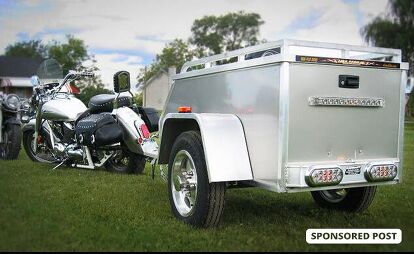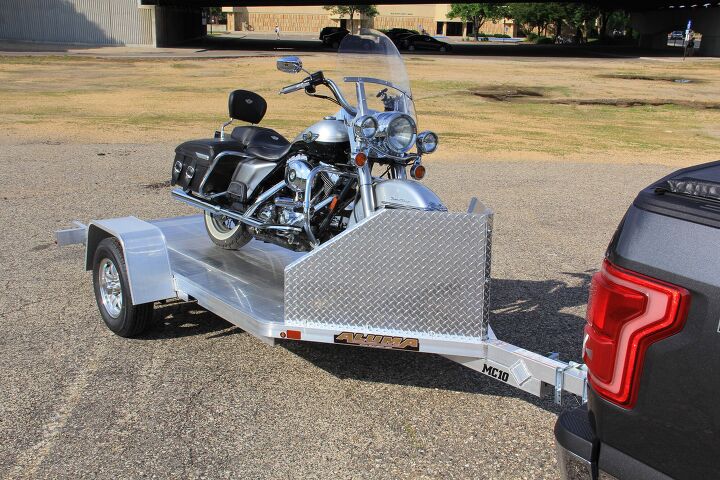Loadin' and Roadin': What You Need to Know About Trailers
Do it right, so you and your bike can get there safe.
We like to think we ride our bikes everywhere, right? That no horizon is too distant, no riding day too long. We are MOrons, with iron butts and steely hearts. But no matter how tough your tush, no matter how much intestinal fortitude you have, there are plenty of situations where it just makes more sense to put your bike and all its ancillary needs onto (or into) a trailer.
Maybe there’s a rally halfway across the country and you don’t want to ride your slammed chopper through a Midwest winter. Or you’re doing a track day with a track-only bike with slicks and no lights (that needs rollers to start). Or you’re going to get dirty at the best OHV park not yet closed by environmentalists… that’s a 3-hour drive away. Trailer time!
The thing is, once you’ve made the mental decision to become a trailer-ist in addition to being a motorcyclist, your level of responsibility ratchets up a bit, because you don’t want to be that guy (or that girl) with the jackknifed rig blocking three lanes on I-80 at rush hour. Do it wrong with a trailer and you’re on the Six O’clock news, or worse, one of those viral “FAIL” videos.
We teamed up with Aluma Trailers – the leading provider of high-quality, American-made aluminum trailers – to give our readers this handy guide to loading and operating your trailer. Read on to avoid some of these common pitfalls.
1. Choose Wisely
First, you need a trailer. But, which one? Buy the trailer that best suits your needs, given your towing missions, cargo and tow vehicle. We are not going to tell you which trailer to buy, but the good folks at Aluma Trailers have a huge selection of high-quality, made-in-the-USA trailers that can handle just about anything you can think of, with pricing for any budget.
Another choice to make is your tow vehicle, which may be easy; it’s probably parked outside right now. Find its maximum tow weight and subtract 10 or 20 percent so you’re not straining its limits. Next, figure out what you need to tow; your bike alone? Or is a buddy going with you? And how about ancillary equipment, like gas cans, tools, spare parts, camping gear, folding chairs, hibachis and margarita makers?
Even if it’s not going on the trailer you should be mindful of the rest of your rig’s payload, as that can make a difference on your vehicle’s tires and performance. Overloading is one of the main causes of tire failure as well as vehicle rollover crashes, so find the GVWR weight of your vehicle (usually on a sticker inside the door, or in your owner’s manual), which is your vehicle’s weight plus the maximum payload, which can be shockingly low: the 2019 Ford Explorer has a GVWR of 6,160 pounds, which sounds impressive until you subtract the SUV’s gassed-up curb weight of 4,458 pounds, meaning all passengers and cargo can’t safely exceed 1,702 pounds. Lastly, when choosing your trailer, pay attention to what kind of hitch you’re using, as well as the hitch height.
2. Load like a Pro
If you’ve ever loaded a pickup truck or van, you’ve probably been more concerned with cramming as much as possible in there than you were with how that load was distributed. Improper weight distribution can cause handling problems, and as we mentioned before, the goal here is to not be that guy, as in that guy with the trailer that’s hopping up and down or whipping from side to side. Keep things steady and safe by keeping the following principles in mind:
Tongue Weight: Hold the mother-in-law jokes, as this is important. That’s the weight your vehicle’s tow hitch is supporting (as opposed to pulling), and it shouldn’t exceed 10% of your tow capacity. The most accurate way to check it is at a commercial truck scale, but you can also buy a ball hitch with a built-in scale (very cool), or jury rig something with a bathroom scale and a box. Obviously that won’t work past the capacity of most bathroom scales.
Load Weight and Distribution: Be smart about how you load. Keep heavy objects close to the axle, and be sure you don’t put heavy loads on one side or the other.
Secure your Load: Your trailer’s suspension isn’t as good as your tow vehicle, which means stuff will get bounced around more. Use tie-downs on everything you want to keep. That goes for your motorcycle as well! Leave some slack in your bike’s suspension (to keep from damaging the springs), but be sure to strap both front and rear wheels, and that they won’t come loose! Be extra careful with fragile items: you may want to keep them in the tow vehicle, and for Pete’s sake, strap down your loading ramp.
Loading and Unloading: leave your trailer hitched securely to your tow vehicle while loading and unloading! You may want to move your tow vehicle at your destination, but keep in mind that once unhitched, your trailer (especially if it only has two wheels) will be unbalanced, even if you set the tongue on a crate or cinder block. It’ll turn into a seesaw if you step onto the back, with possibly unhappy results.
3. Straighten Up and Drive Right
Your trailer and bike are loaded up and you’re ready to go, but your responsibilities don’t end there.
Practice, practice, practice: Learn how to pull a trailer in a safe, low-pressure environment like a quiet residential street or parking lot before you’re stuck in a big-city traffic jam or bombing down a mountain road. Be sure to learn how to back and perform tight turns as well: (see above “that guy” notes.) A handy item might be a backup camera system designed for trailers.
Obey! Read up on laws regarding trailering for the states or countries you’re driving through. Find out what speeds you can drive and what lanes are okay.
Check Yourself Before You Wreck Yourself: We’re not being snarky here. Seriously, after driving your rig a few miles, pull over and check your tow chains, hitch, lights and wheel lug nuts and bearings. If it’s all okay, check it again at every gas stop. Also keep in mind your tow vehicle will be strained, so check its brakes, oil and coolant often. And before your next journey, perform your trailer owner’s manual maintenance checklist, especially those bearings: they’re frequent failure points for trailers.
Be Prepared: If you have room for a spare trailer wheel, take one, or at least a tire-repair kit and compressor. Flares/chem-lights, a fire extinguisher and spare tie downs and tow chains aren’t a bad idea to have along as well.
Conclusion:
We hope this has been a helpful guide, and if it sounds daunting, don’t worry: once you’re set up you’ll find trailers are a safe and practical way to transport your bike and gear to and from distant adventures. Happy Towing!
More by Sponsored


































Comments
Join the conversation
From the opening picture I was looking forward to an article on the finer points of towing a trailer with my bike. Very disappointed to read about towing my bike on a trailer.
I towed a Bunkhouse Popup camper for many years with an '86 Suzuki Cavalcade and then a '95 Gold Wing GL1500. Covered many miles with each roaming this great country.
The Harley jokes write themselves. Are the trailers approved by The Highwayman?